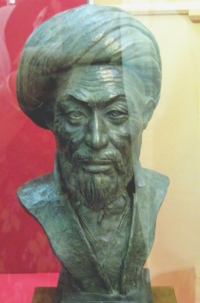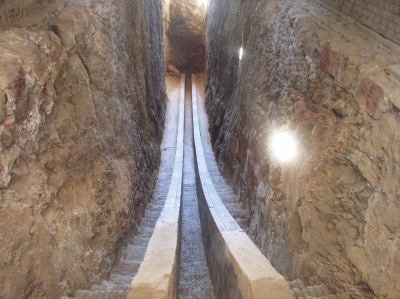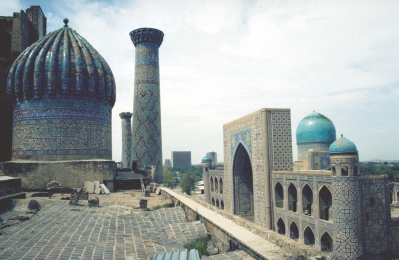| Home - Back Issues - The Team - Contact Us |
 |
| Volume 11 |Issue 43| November 02, 2012 | |
|
|
A Roman Column A CENTRAL ASIAN JOURNEY The Samarkand of Ulugh Beg Neeman Sobhan
I am not a fan of 'the great conquerors' of history: Genghis Khan, Tamerlane, Alexander the Great? What's so glorious about these bad boys of history? I think it's a disgusting lack of good manners to just get on your high horse, ride roughshod on lands that are not yours, trample your neighbour's garden, and rob their homes, just to pull at the bubblegum from your mouth to see whose stretched over the longest terrain. I won't even mention the gratuitous mayhem at the basis of these megalomaniac and vainglorious empires, which we conveniently forget when we admire the architectural splendours that were mostly their monuments to further self-glorification. So even as I ooh! and aah! through my first day of Samarkand visiting gorgeous monuments from Temur's reign, I tell Dennis, our guide that I am not sold to Tamerlane's greatness on account of his extensive kingdom that encroached on India to the east and touched Turkey to the west, but because the architectural glory of Temurid Samarkand, simply cannot be denied. (Nor can the unfortunate fact that it takes an egoistical personality with unlimited power and wealth to sponsor the creation of so much beauty and of such skill, and scale). Thus, on our second day, I tell Dennis that I am prepared again to swoon in appreciation of all that he has planned for us to see. However, today we are changing focus from Temur to his grandson Ulugh Beg who ruled Samarkand for 40 years. Dennis smiled, “You will like him. Unlike Temur, Ulugh wasn't a military genius. He was a mathematical genius, and a rare ruler who was also a patron of the sciences, a brilliant astronomer in his own right and a teacher. It was he who made Samarkand into a centre of learning and art-- an intellectual capital. Yesterday, we had seen the Madrassah or university of Ulugh Beg in the Registan city with the inscription…” “ 'Pursuit of knowledge is the duty of every Muslim, both man and woman.'” I repeated, nodding at Dennis to say, yes, I already liked Ulugh Beg. In fact, since my late night reading on him, I am already interested in this Philosopher King, or accurately, an Astronomer Prince. I tell Dennis that I had read that he made precise calculations of the position of heavenly bodies and the revolutions of the earth a century ahead of people like Copernicus in a great observatory he built in the city.
Dennis says: “And that is exactly what we will visit this morning. In 1424, Ulugh Beg ordered the construction of an observatory, which contained a gigantic but precision-made marble sextant with an arc length of 63 meters, and a 3-story tall astrolabe, one of the largest ever constructed, in order to measure the positions of the stars with unprecedented accuracy. In the Madrassa, the students, in addition to theology and philosophy were mostly taught the sciences and especially, astronomy. To support this study Ulugh Beg built the observatory. It was later destroyed by religious fanatics after his death. The ruins were unearthed in 1908 by Russian archaeologist Vladimir Viatkin.” By now we have arrived at the hill near ancient Afrosiab citadel outside Samarkand. We climb to a flat expanse that seems like a large rooftop, but is actually the foundation that remains of the three story cylindrical structure of the observatory. A decorative portal leads to a view of the underground trench, with its mammoth arch that once contained the huge marble sextant, considered by European experts to be “the largest meridian instrument ever built." As we look down at the penumbra of this tunnel once lined with marble and still containing the calibrations of the scale between 80° and 57° of solar altitude along its length, to gaze at the cradle of the Fakhri Sextant, or the world's largest 90 degree Quadrant some say, which rose 30 metres above ground, I am not just impressed and filled with admiration, I get goose bumps. It is unearthly, the work of a giant attempting to measure the universe of sun, moon and stars. This was the vision of a conqueror not of lands but the seven skies and of celestial knowledge. Ulugh Beg was a renaissance man in medieval times. “Man's reach should exceed his grasp, or what's a heaven for?” sounds inspiring to us. But the narrow minded clergy of Ulugh Beg's time seeing their ruler in his 'arrogant' quest for knowledge exceeding his human grasp to reach a heaven that should lie behind its veils of mystery, got scared and angry. Ulugh Beg paid with his life: he was beheaded, and that too by order of his son. Luckily, the son came to an ignominious end, and Ulugh Beg was later given a proper burial in the tomb of Temur at Gur-Emir. With all this playing on our minds we wandered through the museum within the Observatory complex with extra interest. We saw models of the smaller instruments like astrolabe and sine instruments, and the armillary sphere that would have been placed on the roof. It was amazing to discover the strides that had been made by the scientists of Ulugh Beg's time under his active patronage. He compiled one of the greatest star catalogues, and also determined the length of the year, which remains the most accurate measurement to date at 365 days, 6 hours, 10 minutes and 8 seconds, only about 1 minute longer than the modern electronic calculations. I read somewhere that “The most direct influence of the Samarkand Observatory was on the construction of the five… Jantar Mantars, built by Maharajah Jai Singh (1686-1743) in India…a Hindu prince in the court of a Muslim Mogul emperor.” But these, including the ones in Jaipur and Delhi were built 100 years after the invention of the telescope. The research done at Ulugh Beg Observatory were important at the time as astronomers could predict eclipses and calculate the hour of the rising sun and altitude of a celestial body. Presumably, predicting the timing of the Eid moon was not a great feat for Islamic astronomers then and should not be today! Yet, we still cannot wish each other 'Eid Mubarak' on the same day. NEXT: The Other Samarkands. |
||||||||||||
Copyright
(R) thedailystar.net 2012 |


